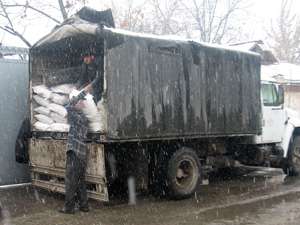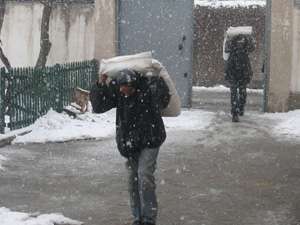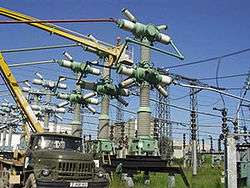2008 Central Asia energy crisis

The 2008 Central Asia energy crisis was an energy shortage in Central Asia, which, combined with the severe weather of the 2007-08 winter (the coldest since 1969[1]) and high prices for food and fuel, caused considerable hardship for many.[2] The abnormally cold weather has pushed demand up for electricity, exacerbating the crisis. The situation is most dire in Tajikistan. An international appeal was made by the United Nations, NGOs, and the Red Cross and Red Crescent for around US$25 million to assist the government.[3] At the time, The UN warned that millions face starvation during the 2008-09 winter.[4]
World Bank debt and price hikes

At the beginning of January 2008, officials announced an electricity price hike of 20 percent to allow the "government [to] repay its debt to the World Bank."[2] According to an official at Barqi Tojik, a national power company, limits will become stricter, and the price for electricity is expected to rise until 2010.[2]
On April 2008, Pradeep Mitra, World Bank chief economist for Europe and Central Asia, issued an uncharacteristic statement, urging the worse-hit countries to spend more on social assistance and "top up" their social programs.[5]
Nonetheless, Mitra focus remained centred "on inflation management," suggesting that the affected countries "especially refrain from imposing controls on trade" (measures recently undertaken by many countries to protect their populations from food price inflation and keep food available domestically), arguing that "it could work against the food supply in the longer term."[5]
Power shortages
As of January 13, 2008, many villages received only one to three hours of electricity per day, and the capital Dushanbe cut power to residential areas overnight.[2] On January 26, 2008, Dushanbe cut power to places of entertainment (including restaurants, shops, pharmacies, markets, and public bathhouses), causing many to close until spring. The few visible lights are from the owners of generators, factories, or people who have illegally tapped the power lines. The restriction was set to end February 10, but there is discussion of extending it.[6] The only exemptions to the restrictions are for government offices, hospitals, and certain industrial cities, such as Tursunzoda, which has a large aluminum plant. Because of inoperable central heating systems in Dushanbe and other cities, residents in apartment blocks have no means other than electricity to heat their homes.[2]
Harsh winter
The situation was exacerbated by the cold winter, with temperatures reaching -20 degrees Celsius. Dushanbe residents report wearing several jackets and overcoats to sleep and all family members sleeping under a single blanket to share warmth.[2] The UN's World Food Programme also declared the food situation one of emergency shortage, in both cities and rural areas.[7]
Allegations of media suppression
As of mid-January 2008, the state-run media did not discuss the problem.[2] Subsequently throughout the month of February, there emerged numerous Western media reports of children dying in maternity wards of hospitals during blackouts. The Tajik government maintains that the blackouts were not responsible for any deaths.[8] The Tajik government has appealed for international aid.[9] Meanwhile, aid workers and diplomats urged the government to declare a state of emergency.[8] The handling of the crisis has raised questions about the competence of the political leadership.[10]
Famine warning
According to the weblog news service neweurasia, as of March 3, 2008 the crisis in Tajikistan has eased: "From now on (at least till the next winter) Dushanbe is not going to have problems with electricity and the tough schedule introduced in the beginning of this winter was abandoned on March 1, 2008 in Dushanbe by the decision of Barqi Tojik."[11] The Christian Science Monitor, neweurasia, and other media observers are predicting that a nascent hunger crisis will erupt into a full famine as a consequence of the energy shortages.[12] UN experts announced on 10 October that almost one-third of Tajikistan’s 6.7 million inhabitants may not have enough to eat for the winter of 2008-09.[4]
Kyrgyzstan

In Kyrgyzstan, also rich in hydroelectric resources, the cold weather has made demand 10% higher than the same time last year, which is depleting the main Toktogul reservoir for hydroelectric power.[10]
Uzbekistan
Beginning in late December 2007, the unusually harsh weather has frozen the gas supply to numerous homes and businesses across Uzbekistan. As a result, there have been numerous demonstrations and protests against the government, in favor of an insured uninterrupted supply of gas and electricity.[13] The government response has varied; in Karakalpakstan, they met protesters and promised to rectify the situation, while the local government head of Hazarasp responded to a complaint by one woman by cutting off gas altogether to all the houses on her street.[13]
Some in Uzbekistan have turned to "traditional methods" for heating, and there are reportedly some villages which have no trees left, because villagers have cut them down to heat their homes and cook food. This is expected to have a negative effect on the economy, because the leaves are essential to the local silk industry, and the fruit grown is the main source of income for many villagers.[2]
Turkmenistan
In some provinces of Turkmenistan, villagers were burning saxaul plants, a traditional Turkmen way to heat homes, since in the cities, the central heating pipes have been neglected and failed to produce adequate heat.[2]
See also
- 2008 Bulgarian Energy Crisis
- Energy crisis
- 2000s commodities boom
- Global storm activity of 2008
- Global storm activity of 2007
References
- ↑ GHCN Climate data for Tashkent 1880 to 2008
- 1 2 3 4 5 6 7 8 9 Farangis Najibullah (January 13, 2008). "Tajikistan: Energy shortages, extreme cold create crisis situation". EurasiaNet. Archived from the original on 2010-01-16. Retrieved 2008-02-08.
- ↑ Situation Report No. 4 – Tajikistan – Cold Wave/Compound crisis (25 February 2008) United Nations Office for the Coordination of Humanitarian Affairs
- 1 2 Tajikistan: Almost One-Third of the Population Is in Danger of Going Hungry This Winter | EurasiaNet.org
- 1 2 , UNIAN, April 16, 2008
- ↑ Nafisa Pisarejeva (February 1, 2008). "Tajiks Pull the Plug on Cafés". Institute for War and Peace Reporting. Archived from the original on 19 February 2008. Retrieved 2008-02-09.
- ↑ Natalia Antelava (February 6, 2008). "Tajikistan 'facing food crisis'". BBC News. Archived from the original on 9 February 2008. Retrieved 2008-02-09.
- 1 2 Ivan Watson (February 8, 2008). "Crisis Looms as Bitter Cold, Blackouts Hit Tajikistan". National Public Radio All Things Considered. Archived from the original on 10 February 2008. Retrieved 2008-02-09.
- ↑ "Severe energy crisis leaves Tajikistan without heat and water". CARE International. February 7, 2008. Retrieved 2008-02-08.
- 1 2 Jyldyz Mamytova and Yaroslav Razumov (January 31, 2008). "Cold Snap Wreaks Havoc on Central Asian Power". Institute for War and Peace Reporting. Archived from the original on 17 February 2008. Retrieved 2008-02-08.
- ↑ Vadim (March 3, 2008). "Electricity crisis solved in Dushanbe". neweurasia. Archived from the original on December 2, 2008.
- ↑ Vadim (March 4, 2008). "Hunger to replace energy crisis". neweurasia. Archived from the original on January 14, 2009.
- 1 2 "Uzbekistan Sees Rare Protests Over Gas Shortage". Institute for War and Peace Reporting. January 25, 2008. Retrieved 2008-02-09.